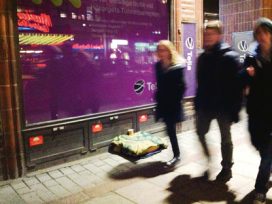The wall
Since 2003, graffiti artists worldwide have been leaving their marks on the Palestinian side of the demarcation wall being built between Palestinian and Israeli territory. Swedish artist Cecilia Parsberg’s photographs record what she calls “an international multitude, a writing-carpet”. “I am primarily interested in the phenomena of people coming from other countries to paint on the wall, and that they paint on one side of it,” she says. “The core of this type of network is the connection between the place and activity, the clash of different aesthetic expressions, that there is no typical graffiti-aesthetic.” Are Parsberg’s photographs evidence of a larger movement of aesthetic resistance to the changing value systems of globalization in art and society?
Cecilia Parsberg
Palestinian artists and cultural workers talk about the “art” drawn on the wall demarcating Palestinian and Israeli territory. Their opinions are revealing of the wall’s significance in the Palestinian experience and the function of “network as resistance”. [ more ]
About the artist
Cecilia Parsberg lives and works in Stockholm, Sweden. She is a visual artist who works with relational concepts, and was educated at Valand Academy of Fine Arts, Gothenburg University, Sweden, with a post-grad Diploma from Dundee University, UK.
In the early 1990s, she contributed to the development of Valand’s educational programme in digital media for artists, where she also taught for several years. From 1999 to 2002, she was professor at the Academy of Fine Arts, Umeå University, Sweden. For two periods between 2000 and 2002, she was guest professor in the Fine Arts Department at Witwatersrand University, Johannesburg, South Africa. She has held many workshops at art academies in Sweden, Norway, and the US in art/activism as well as relational art practices.
At the moment, she is showing in Sweden: the installation “A heart from Jenin” at BildMuseet, Umeå; a permanent installation in Rinkeby; the film “The holy land” with Maj Wechselman, which had its premiere at the Gothenburg International Film Festival in January 2006; and photos in the exhibition “Konstfeminism” at Liljevalchs Konsthall, Stockholm, Sweden, June 15 to August 27.
She is also exhibiting “Wrestling” in the show Human Games, organized by Fransesco Bonami at Fondazione Pitti Discovery, Florence, Italy, June 21 to July 23.
An account of her work and earlier exhibitions can be found at http://this.is/Parsberg.
Throughout the 1990s, her work dealt with power and sexuality, how power structures permeate our daily lives. Her gaze changed from the outsider to the participant: the image exists between us, the task of the artist is to “activate the image”. The theoretical concept “The Action” was articulated through five artworks in South Africa over a period of three years. For the past five years, she has been articulating her art projects as real political postures. Cecilia argues that this sphere is a possible place for artists’ work.
The question of how art participates in social processes is also about the role of the artist; since February, she has been connected to the network DIRECT, with its emphasis on strategies for art and civic entrepreneurship; for three years, she has also worked with the network Bwana Club.
Published 30 May 2006
Original in English
© Cecilia Parsberg Eurozine
PDF/PRINTNewsletter
Subscribe to know what’s worth thinking about.


